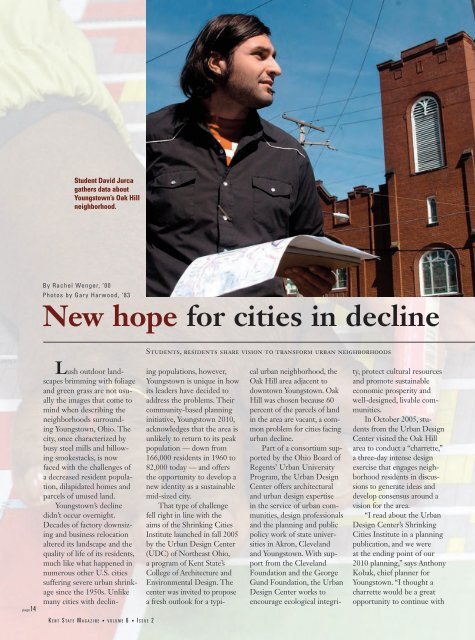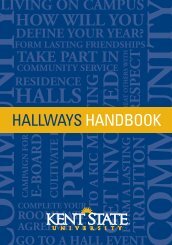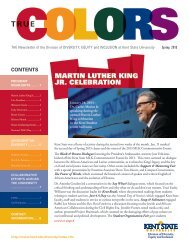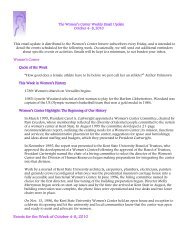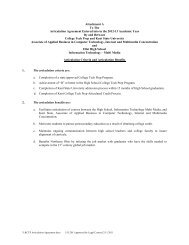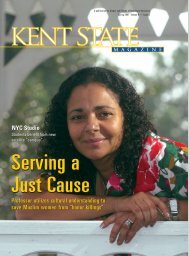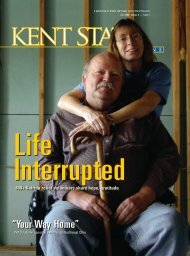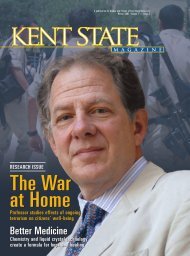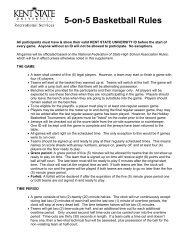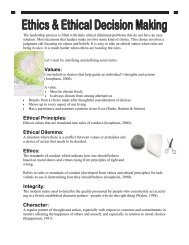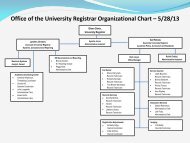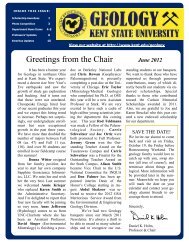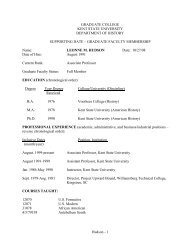Lester Lefton Lester Lefton - Kent State University
Lester Lefton Lester Lefton - Kent State University
Lester Lefton Lester Lefton - Kent State University
Create successful ePaper yourself
Turn your PDF publications into a flip-book with our unique Google optimized e-Paper software.
Student David Jurca<br />
gathers data about<br />
Youngstown’s Oak Hill<br />
neighborhood.<br />
By Rachel Wenger, ’00<br />
Photos by Gary Harwood, ‘83<br />
New hope for cities in decline<br />
p a g e14<br />
Lush outdoor landscapes<br />
brimming with foliage<br />
and green grass are not usually<br />
the images that come to<br />
mind when describing the<br />
neighborhoods surrounding<br />
Youngstown, Ohio. The<br />
city, once characterized by<br />
busy steel mills and billowing<br />
smokestacks, is now<br />
faced with the challenges of<br />
a decreased resident population,<br />
dilapidated homes and<br />
parcels of unused land.<br />
Youngstown’s decline<br />
didn’t occur overnight.<br />
Decades of factory downsizing<br />
and business relocation<br />
altered its landscape and the<br />
quality of life of its residents,<br />
much like what happened in<br />
numerous other U.S. cities<br />
suffering severe urban shrinkage<br />
since the 1950s. Unlike<br />
many cities with declining<br />
populations, however,<br />
Youngstown is unique in how<br />
its leaders have decided to<br />
address the problems. Their<br />
community-based planning<br />
initiative, Youngstown 2010,<br />
acknowledges that the area is<br />
unlikely to return to its peak<br />
population — down from<br />
166,000 residents in 1960 to<br />
82,000 today — and offers<br />
the opportunity to develop a<br />
new identity as a sustainable<br />
mid-sized city.<br />
That type of challenge<br />
fell right in line with the<br />
aims of the Shrinking Cities<br />
Institute launched in fall 2005<br />
by the Urban Design Center<br />
(UDC) of Northeast Ohio,<br />
a program of <strong>Kent</strong> <strong>State</strong>’s<br />
College of Architecture and<br />
Environmental Design. The<br />
center was invited to propose<br />
a fresh outlook for a typical<br />
urban neighborhood, the<br />
Oak Hill area adjacent to<br />
downtown Youngstown. Oak<br />
Hill was chosen because 60<br />
percent of the parcels of land<br />
in the area are vacant, a common<br />
problem for cities facing<br />
urban decline.<br />
Part of a consortium supported<br />
by the Ohio Board of<br />
Regents’ Urban <strong>University</strong><br />
Program, the Urban Design<br />
Center offers architectural<br />
and urban design expertise<br />
in the service of urban communities,<br />
design professionals<br />
and the planning and public<br />
policy work of state universities<br />
in Akron, Cleveland<br />
and Youngstown. With support<br />
from the Cleveland<br />
Foundation and the George<br />
Gund Foundation, the Urban<br />
Design Center works to<br />
encourage ecological integrity,<br />
protect cultural resources<br />
and promote sustainable<br />
economic prosperity and<br />
well-designed, livable communities.<br />
In October 2005, students<br />
from the Urban Design<br />
Center visited the Oak Hill<br />
area to conduct a “charrette,”<br />
a three-day intense design<br />
exercise that engages neighborhood<br />
residents in discussions<br />
to generate ideas and<br />
develop consensus around a<br />
vision for the area.<br />
“I read about the Urban<br />
Design Center’s Shrinking<br />
Cities Institute in a planning<br />
publication, and we were<br />
at the ending point of our<br />
2010 planning,” says Anthony<br />
Kobak, chief planner for<br />
Youngstown. “I thought a<br />
charrette would be a great<br />
opportunity to continue with<br />
6<br />
2


